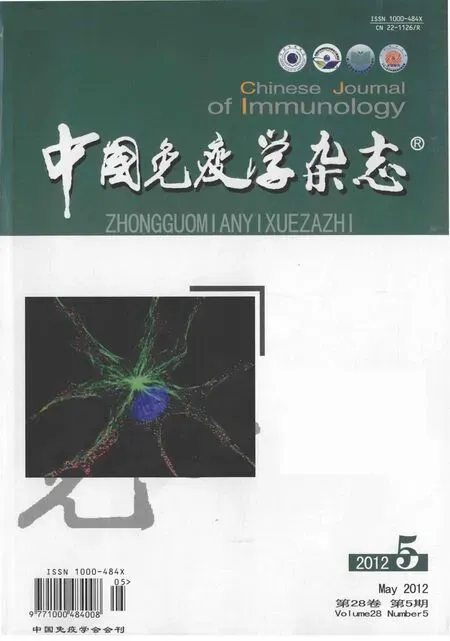白细胞介素与肿瘤研究进展①
高 昆 张连峰
(中国医学科学院实验动物研究所北京协和医学院比较医学中心卫生部人类疾病比较医学重点实验室,北京100021)
白细胞介素(Interleukin,IL)最初被发现是一种由白细胞产生的分泌型蛋白或信号分子,它能够非特异性地调节机体免疫反应,并在炎症反应中发挥重要作用。近年来有许多关于白细胞介素与肿瘤发生、发展相关方面研究的报道,本文主要对与肿瘤相关的白细胞介素进行综述。
1 IL-1
IL-1主要由活化的巨噬细胞产生,其生物学功能主要是促进T、B细胞的增殖和分化,协同IL-2、IFN-γ诱导产生CTL,增强NK细胞活性。经过学者们多年的研究发现炎症介质和细胞因子在肿瘤局部环境中发挥着重要作用[1]。IL-1作为一种重要的促炎性细胞因子[2],它能够促进趋化性细胞因子释放,吸引中性粒细胞来影响肿瘤的发生、发展及转移,肿瘤局部侵润的中性粒细胞是产生活性氧及致癌作用的关键细胞。另外IL-1还能够诱导粘附分子及金属蛋白酶的产生从而促进肿瘤的侵袭。IL-1主要有IL-1α及 IL-1β两种存在形式,它们作用于相同的受体IL-1RⅠ,同时募集IL-1受体辅助蛋白(IL-1RAcP)触发信号转导,而后活化IL-1受体相关激酶-1(IRAK-1)及IL-1受体相关激酶-2(IRAK-2),IRAK-1活化并募集泛素连接酶TRAF6,TRAF6能够激活 NF-κB 及 MAPK/c-Jun 两条信号通路[3-5]。IL-1α及IL-1β均能促进炎症反应及刺激产生前列腺素E2(PGE2)。与IL-1α相比,IL-1β在炎症反应中的作用更为重要,Fantuzzi等[6]的研究结果显示在炎症刺激物诱导下IL-1β基因缺陷小鼠未产生炎症反应。IL-1α、IL-1β二者在肿瘤中发挥不同的作用,天然的膜结合型IL-1α能够像粘附分子一样增效肿瘤细胞与携带IL-1R的免疫效应细胞之间的相互作用,通过激发机体免疫细胞对肿瘤的杀伤而抑制肿瘤发生。而IL-1β则通过促进肿瘤血管生成及诱导宿主的免疫抑制而增强肿瘤的侵袭性,研究发现表达IL-1β的肿瘤细胞具有更强的侵袭与转移特性,并且能够产生由未成熟CD11b+/Gr-1+髓样细胞介导的T细胞免疫抑制[7-9]。
2 IL-6
IL-6是由巨噬细胞、成纤维细胞、内皮细胞等产生的一种多功能细胞因子。IL-6能够促进T、B细胞的增殖与分化,诱导巨噬细胞及巨核细胞分化,活化破骨细胞,且与炎症反应及自身免疫性疾病等相关[10]。IL-6通过与IL-6受体结合发挥其生物学作用,IL-6与 IL-6Rα亚基结合后,使得 IL-6Rβ亚基(gp130)形成二聚体,从而活化其下游的 JAK1/STAT3 信号通路,发挥其生物学功能[11,12]。IL-6 能够在多种人类肿瘤中激活STAT3,在原发性人肺腺癌中突变的表皮生长因子受体(EGFR)能够以上调IL-6的方式激活 gp130/JAK/STAT3通路[13]。研究发现IL-6水平的升高与肝细胞癌有关,IL-6能够通过激活STAT3信号提高阿霉素处理的人肝癌细胞的存活率[14]。肿瘤局部IL-6的水平对临床预后也有影响,在宫颈癌中肿瘤局部IL-6基因的高表达与预后不良相关[15],唾液中IL-6的水平在舌鳞状上皮细胞癌(TSCC)从高危到产生赘生物进展过程存在差异,IL-6可能成为肿瘤筛查及早期检测的生物学指标。另有研究发现肥大细胞产生的IL-6在TLR2介导的肿瘤生长抑制中起重要作用,体内肥大细胞重建实验也证明了这一点[16-18]。
3 IL-12
IL-12是一种重要的免疫调节细胞因子,由p35和p40两个亚基组成,其作用的受体分别为 IL-12Rβ1及IL-12Rβ2,主要表达于抗原递呈细胞表面。它能够促进T细胞、NK细胞增殖,刺激CD4+T细胞分化为Ⅰ型辅助型T细胞,并通过活化STAT4通路增强 CTL的活性[19,20]。由于 IL-12能够促进Th1细胞的分化,因此它在Ⅰ型细胞介导的抗肿瘤免疫中具有重要作用。IL-12诱导产生IFN-γ,IFN-γ能够上调MHCⅠ及Ⅱ类分子、ICAM-1等粘附分子、T-bet等转录因子的表达,这些有利于激发免疫细胞对肿瘤的作用。另外,IL-12还能够诱导产生抗血管生成趋化因子,例如IFN-γ诱导蛋白(IP-10,CXCL10)以及 IFN-γ诱导产生的单核因子(MIG,CXCL9)[21]。IL-12不仅能够增强机体的抗肿瘤免疫应答而且能够降低具有免疫抑制功能细胞的活性。Steding等在研究中发现IL-12具有调节髓样抑制性细胞(MDSC)活性的能力,MDSC在肿瘤微环境中发挥着重要作用,它能够抑制肿瘤微环境中T细胞的活性,促进肿瘤的生长与转移。研究结果显示IL-12能够降低乳腺癌肿瘤微环境中MDSC的百分比,升高CD8+T细胞的百分比,在提高生存率的同时也减少了转移灶[22]。最近有学者研究发现IL-12对肿瘤的抑制作用并非由T细胞或NK细胞介导的,而是依赖于一种表达转录活化因子 RORγt的NKp46+淋巴组织诱导(LTi)细胞。这种 NKp46+LTi细胞能够上调肿瘤脉管系统粘附分子的表达,从而使得更多白细胞浸润至肿瘤局部[23]。
4 IL-23
IL-23属于IL-12家族的成员,主要由活化的DC细胞释放产生,能够影响T细胞的成熟与分化,在细胞介导的免疫中发挥重要作用。IL-23由其自身特异性的p19亚基及IL-12p40亚基组成,这两个亚基作用的受体分别为IL-23R及IL-12Rβ1。IL-23能够激活STAT3,优先作用于记忆性CD4+T细胞,能够诱导产生IL-17、IL-22等细胞因子,并在维持Th17细胞的生物学功能及其扩增中具有重要作用[24,25]。研究发现外源性IL-23过表达具有抗肿瘤效应,转染IL-23的小鼠结肠癌CT26细胞及黑色素瘤B16F10细胞均表现出很强的抗肿瘤及抗转移效应,而这种外源性IL-23介导的抗肿瘤效应主要依赖于记忆性T细胞[26]。与外源性IL-23不同,许多研究显示内源性的IL-23能够促进肿瘤的发生,其作用机制主要为IL-23能够诱发炎性反应包括IL-17的释放,通过活化 STAT3促进肿瘤的发生发展[27]。在多种人类肿瘤中都存在IL-23表达增加,IL-23表达对于肿瘤微环境中的局部炎症反应和上皮内淋巴细胞浸润起负调控作用[28]。IL-23能够通过上调基质金属蛋白酶9(MMP9)增强炎症反应,促进血管生成,减少CD8+T细胞的浸润。研究发现移植肿瘤在IL-23衰竭或IL-23受体缺陷的小鼠中生长受限,该研究证明了IL-23是联系肿瘤促发的炎症反应和机体对肿瘤适应性免疫监视失效之间的重要分子[29]。
5 IL-27
IL-27也是IL-12家族的成员之一,由活化的树突状细胞(DC)产生,它通过上调ICAM-1及T-bet的方式参与诱导早期Th1细胞的分化,并能够促进初始T细胞(naive T cell)增殖,诱导产生Tr1及CTL细胞,抑制Th2细胞、Th17细胞以及促炎性细胞因子的产生。它还能够与IL-12协同刺激T细胞产生IFN-γ,在调控细胞介导的免疫方面具有重要作用[30,31]。IL-27 由 p28 和 EBV 诱导基因 3(EBI3)两个亚基组成,其作用的受体分别为 WSX-1及gp130,能够活化STAT1及STAT3信号,发挥抗肿瘤免疫应答效应[32]。IL-27具有较强的抗肿瘤活性,其作用机制主要包括CD8+T细胞、NK细胞介导的抗肿瘤效应,抗体依赖的细胞介导的细胞毒作用(ADCC)、抗肿瘤血管生成作用、直接抑制肿瘤细胞生长以及抑制COX-2的表达等,但具体依赖何种机制还取决于肿瘤自身的特性。研究发现IL-27在人食管癌细胞(Eca109)中的抗肿瘤效应是通过活化NK细胞及产生炎性反应来实现的[33]。在使用小鼠结肠癌C26肿瘤模型评价IL-27抗肿瘤作用的研究中发现,这种抗肿瘤作用主要是由CD8+T细胞、IFN-γ 及 T-bet介导[34]。而在 Chiyo 等[35]的研究中发现小鼠结肠癌C26局部表达的IL-27的抗肿瘤作用主要依赖于T细胞和NK细胞。在对IL-27的抗肿瘤和抗血管生成活性的研究中发现,IL-27不仅能够抑制小鼠黑色素瘤细胞(B16F10)皮下的生长,而且对实验性肺转移模型也具有抗肿瘤作用,并能够明显抑制肺转移灶中肿瘤诱导的新生血管形成[36]。
6 IL-32
IL-32主要由T细胞、NK细胞和上皮细胞产生,它具有促炎性细胞因子的特性,能够通过激活P38MAPK和NF-κB信号通路诱导产生IL-1β、IL-6、TNF-α等促炎性细胞因子,在固有免疫应答和特异性免疫应答中发挥重要作用[37,38]。IL-32在健康人上皮细胞中的表达水平很低,但在某些疾病中表达水平显著升高。例如慢阻肺、克罗恩病、银屑病等。在人类胃癌、肺癌、乳腺癌及胰腺癌组织中也发现其表达升高[39-41]。Sorrentino 等[42]发现在 73%的腺癌及癌前病变、64%的肺大细胞癌和77%的肺小细胞癌中IL-32的表达也是明显上调的,并且其在肿瘤浸润性淋巴细胞(TIL)及肿瘤细胞(TC)中的表达与侵袭和迁移表型有关,故其有可能成为评价临床预后的指标。研究发现IL-32γ能够通过抑制NF-κB及STAT3信号从而抑制肿瘤细胞的生长,在T细胞凋亡过程中IL-32能够特异性表达,并且IL-32表达下调能够抑制Hela细胞的凋亡,然而也有研究发现IL-32能够促进胰腺癌细胞的生长[43-45]。
7 结语和展望
随着对白细胞介素在肿瘤中作用研究的不断发展,学者们通过体内外实验或临床标本分析发现了多种与肿瘤相关的白细胞介素,及其相关的作用机制及信号通路,针对白细胞介素调节的效应细胞或信号通路中的某一环节都有可能为今后临床抗肿瘤治疗提供新的靶点。
1 Alberto Mantovani,Paola Allavena1,Antonio Sica et al.Cancer-related inflammation[J].Nature,2008;454(24):436-444.
2 Dinarello C A.Immunological and inflammatory functions of the interleukin-1 family[J].Annu Rev Immunol,2009;27:519-550.
3 Greenfeder S A.Molecular cloning and characterization of a second subunit of the interleukin 1 receptor complex[J].J Biol Chem,1995;270:13757-13765.
4 Goldberg J E,Schwertfeger K L.Proinflammatory cytokines in breast cancer:mechanisms of action and potential targets for therapeutics[J].Curr Drug Targets,2010;11(9):1133-1146.
5 Wang D,Zhang S,Li L et al.Structural insights into the assembly and activation of IL-1β with its receptors[J].Nat Immunol,2010;11(10):905-911.
6 Fantuzzi G,Dinarello C A.The inflammatory response in interleukin-1 beta-deficient mice:comparison with other cytokinerelated knockout mice[J].J Leukoc Biol,1996;59:489-493.
7 Charles A,Dinarello.The paradox of pro-inflammatory cytokines in cancer[J].Cancer Metastasis Rev,2006;25:307-313.
8 Song X,Voronov E,Dvorkin T et al.Differential effects of IL-1alpha and IL-1beta on tumorigenicity patterns and invasiveness[J].J Immun,2003;171:6448-6456.
9 Song X,Krelin Y,Dvorkin T et al.CD11b+/Gr-1+immature myeloid cells mediate suppression of T cells in mice bearing tumors of IL-1β-secreting Cells[J].J Immun,2005;175:8200-8208.
10 Kishimoto T.Interleukin-6:discovery of a pleiotropic cytokine[J].Arthritis Res Ther,2006;8(Suppl 2):S2.
11 Rodig S J,Meraz M A,White J M et al.Disruption of the Jak1 gene demonstrates obligatory and nonredundant roles of the Jaks in cytokine-induced biologic responses[J].Cell,1998;93:373-383.
12 Heinrich P C,Behrmann I,Muller-Newen G et al.Interleukin-6-type cytokine signalling through the gp130/Jak/STAT pathway[J].Bio Chem J ,1998;334:297-314.
13 Gao S P,Mark K G,Leslie K et al.Mutations in the EGFR kinase domain mediate STAT3 activation via IL-6 production in human lung adenocarcinomas[J].J Clin Invest,2007;117(12):3846-3856.
14 Liu Y,Li P K,Li C et al.Inhibition of STAT3 signaling blocks the anti-apoptotic activity of IL-6 in human liver cancer cells[J].J Biol Chem,2010;285(35):27429-27439.
15 Pages F,Vives V,Sautes-Fridman C et al.Control of tumor development by intratumoral cytokines[J].Immunol Lett,1999;68(1):135-139.
16 Korostoff A,Reder L,Masood R et al.The role of salivary cytokine biomarkers in tongue cancer invasion and mortality[J].Oral Oncol,2011;47(4):282-287.
17 Knupfer H,Preiss R.Significance of interleukin-6(IL-6)in breast cancer[J].Breast Cancer Res Treat,2007;102(2):129-135.
18 Oldford S A,Haidl I D,Howatt M A et al.A critical role for mast cells and mast cell-derived IL-6 in TLR2-mediated inhibition of tumor growth[J].J Immunol,2010;185(11):7067-7076.
19 Trinchieri G.“Interleukin-12:a proinflammatory cytokine with immunoregulatory functions that bridge innate resistance and antigenspecific adaptive immunity[J].Annual Review of Immunology,1995;13:251-276,
20 Gately M K,Renzetti L M,Magram J et al.The interleukin-12/interleukin-12-receptor system:role in normal and pathologic immune responses[J].Annual Review of Immunology,1998;16:495-521.
21 Colombo M P,Trinchieri G.Interleukin-12 in antitumor immunity and immunotherapy[J].Cytokine and Growth Factor Reviews,2002;13(2):155-168
22 Steding C E,Wu S T,Zhang Y et al.The role of interleukin-12 on modulating myeloid-derived suppressor cells,increasing overall survival and reducing metastasis[J].Immunology,2011;133(2):221-238.
23 Eisenring M,vom Berg J,Kristiansen G et al.IL-12 initiates tumor rejection via lymphoid tissue-inducer cells bearing the natural cytotoxicity receptor NKp46[J].Nat Immunol,2010;11(11):1030-1038.
24 Aggarwal S,Ghilardi N,Xie M H et al.Interleukin-23 promotes a distinct CD4 T cell activation state characterized by the production of interleukin-17[J].J Bio Chem,2003;278(3):1910-1914.
25 Zheng Y,Danilenko D M,Valdez P et al.Interleukin-22,a TH17 cytokine,mediates IL-23-induced dermal inflammation and acanthosis[J].Nature,2007;445(7128):648-651.
26 Oniki S,Nagai H,Horikawa T et al.Interleukin-23 and interleukin-27 exert quite different antitumor and vaccine effects on poorly immunogenic melanoma[J].Cancer Research,2006;66(12):6395-6404.
27 Xu M,Mizoguchi I,Morishima N et al.Regulation of antitumor immune responses by the IL-12 family cytokines,IL-12,IL-23,and IL-27[J].Clin Dev Immunol,2010;832454:1-9.
28 Langowski J L,Kastelein R A,Oft M.Swords into plowshares:IL-23 repurposes tumor immune surveillance[J].Trends in Immunology,2007;28(5):207-212.
29 Langowski J L,Zhang X,Wu L et al.L-23 promotes tumour incidence and growth[J].Nature,2006;442(7101):461-465.
30 Pflanz S,Timans J C,Cheung J et al.IL-27,a heterodimeric cytokine composed of EBI3 and p28 protein,induces proliferation of naive CD4+T cells[J].Immunity,2002;16(6):779-790.
31 Owaki T,Asakawa M,Morishima N et al.A role for IL-27 in early regulation of Th1 differentiation[J].J Immun,2005;175(4):2191-2200.
32 Hisada,M Kamiya,S Fujita K et al.Potent antitumor activity of interleukin-27[J].Cancer Research,2004;64(3):1152-1156.
33 Liu L,Wang S,Shan B et al.IL-27-mediated activation of natural killer cells and inflammation produced antitumour effects for human oesophageal carcinoma cells[J].Scand J Immunol,2008;68(1):22-29.
34 Hisada M,Kamiya S,Fujita K et al.Potent antitumor activity of interleukin-27[J].Cancer Res,2004;64(3):1152-1156.
35 Chiyo M,Shimozato O,Yu L et al.Expression of IL-27 in murine carcinoma cells produces antitumor effects and induces protective immunity in inoculated host animals[J].Int J Cancer,2005;115(3):437-442.
36 Shimizu M,Shimamura M,Owaki T et al.Antiangiogenic and antitumor activities of IL-27[J].J Immunol,2006;76(12):7317-7324.
37 Dahl C A,Schall R P,He H et al.Identification of a novel gene expressed in activated natural killer cells and T cells[J].J Immunol,1992;148:597-603.
38 Nold-Petry C A,Nold M F,Zepp JA et al.IL-32-dependent effects of IL-1beta on endothelial cell functions[J].Proc Natl Acad Sci USA,2009;106:3883-3888.
39 Dinarello C A,Kim S H.IL-32,a novel cytokine with a possible role in disease[J].Ann Rheum Dis,2006;65(3):61-64.
40 Felaco P,Castellani M L,De Lutiis M A.IL-32:a newly-discovered proinflammatory cytokine[J].J Biol Regul Homeost Agents,2009;23(3):141-147.
41 Seo E H,Kang J,Kim K H et al.Detection of expressed IL-32 in human stomach cancer using ELISA and immunostaining[J].J Microbiol Biotechnol,2008;18(9):1606-1612.
42 Sorrentino C,Di Carlo E.Expression of IL-32 in human lung cancer is related to the histotype and metastatic phenotype[J].Am J Respir Crit Care Med,2009;180(8):769-779.
43 Goda C,Kanaji T,Kanaji S et al.Involvement of IL-32 in activation-induced cell death in T cells[J].Int Immunol,2006;18(2):233-240.
44 Nishida A,Andoh A,Inatomi O et al.Interleukin-32 expression in the pancreas[J].J Biol Chem,2009;284:17868-17876.
45 Oh J H,Cho M C,Kim J H et al.IL-32γ inhibits cancer cell growth through inactivation of NF-κB and STAT3 signals[J].Oncogene,2011;30(30):3345-3359.

